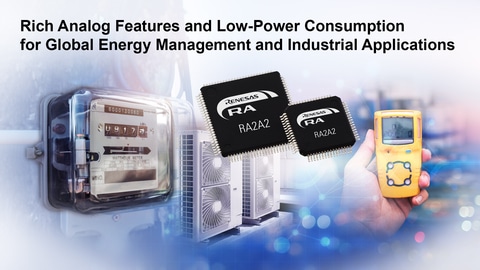The microcontrollers offer low-power operation for energy management, IoT applications, and firmware updates in smart devices.

Renesas Electronics Corporation, a provider of advanced semiconductor solutions, has launched the RA2A2 microcontroller (MCU) Group, powered by the Arm Cortex-M23 processor. The low-power MCUs feature a 24-bit Sigma-Delta analogue-to-digital converter (SDADC) and a unique dual-bank code flash with bank swap functionality, simplifying firmware over-the-air (FOTA) updates for applications in smart energy management, building automation, medical devices, consumer electronics, and other IoT areas.
The MCUs are designed for energy efficiency, offering multiple power structures and voltage detection hardware for ultra-low power operation, as low as 100 µA/MHz in active mode and 0.40µA in software standby mode. They also include an independent power supply real-time clock for extended battery life in demanding conditions, AES hardware acceleration, a high-precision on-chip oscillator, a temperature sensor, and a wide operating voltage range from 1.6V to 5.5V.
Optimized for smart energy management, the RA2A2 MCUs support the digitalization of traditional systems with features like high-level analogue sensing, FOTA support, hybrid sampling, and AES hardware acceleration. For instance, next-generation smart electricity meters equipped with Non-Intrusive Load Management (NILM) technology can monitor energy consumption by analyzing the current and voltage of the total load, offering a cost-effective and scalable solution for enhancing energy efficiency and reducing consumption.
Key Features of the RA2A2 Group MCUs include:
- Core: 48MHz Arm Cortex-M23
- Memory: 512KB integrated, dual-bank Flash memory and 48KB SRAM
- Analog Peripherals: 24-bit Sigma Delta ADC with a digital filter, 12-bit ADC, and temperature sensor.
- Packages: 100-, 80- and 64-pin LFQFP
The MCUs come with support for Renesas’ Flexible Software Package (FSP), which speeds up application development by offering necessary infrastructure software, such as RTOS, BSP, peripheral drivers, middleware, and security stacks, along with reference software for AI, motor control, and cloud solutions. It allows for the integration of legacy code and the choice of RTOS with FSP, providing flexibility in application development. Additionally, using the FSP simplifies the migration of RA2A2 designs to larger RA devices if desired.






